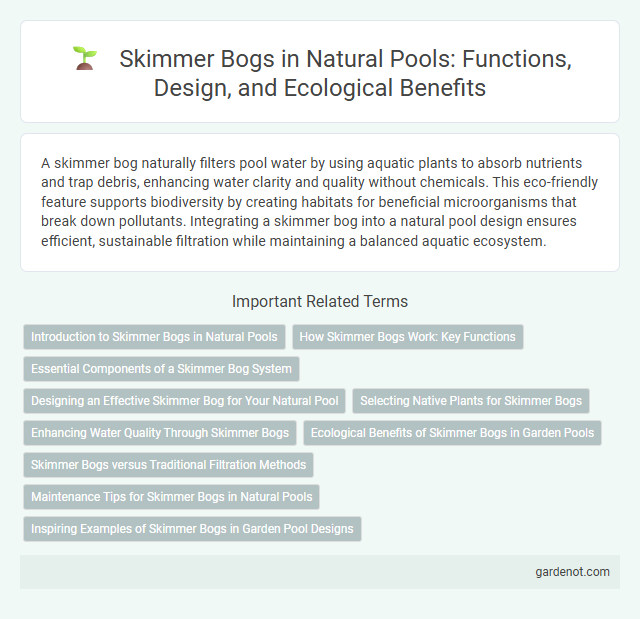A skimmer bog naturally filters pool water by using aquatic plants to absorb nutrients and trap debris, enhancing water clarity and quality without chemicals. This eco-friendly feature supports biodiversity by creating habitats for beneficial microorganisms that break down pollutants. Integrating a skimmer bog into a natural pool design ensures efficient, sustainable filtration while maintaining a balanced aquatic ecosystem.
Introduction to Skimmer Bogs in Natural Pools
Skimmer bogs in natural pools serve as a biological filtration system, using aquatic plants to absorb nutrients and improve water quality. These bogs enhance ecosystem balance by reducing algae growth and supporting beneficial microorganisms. Properly designed skimmer bogs integrate seamlessly with natural pools, promoting clear, chemical-free water.
How Skimmer Bogs Work: Key Functions
Skimmer bogs function by filtering pool water through a planted wetland area that traps debris and absorbs nutrients, preventing algae growth. The system uses a skimmer to draw water into the bog where aquatic plants and beneficial microbes naturally purify the water. This biological filtration enhances water clarity and supports a balanced ecosystem in natural swimming pools.
Essential Components of a Skimmer Bog System
A Skimmer Bog system includes essential components such as a skimmer box, which collects debris from the water surface to maintain clarity. Filtration media like gravel and sand provide a habitat for beneficial bacteria, aiding in natural water purification. Aquatic plants rooted in the bog zone enhance nutrient absorption, preventing algae growth and supporting ecosystem balance.
Designing an Effective Skimmer Bog for Your Natural Pool
Designing an effective skimmer bog for your natural pool involves strategically selecting native aquatic plants that excel in nutrient absorption and water filtration. Position the bog near the pool's skimmer intake to maximize debris capture and enhance water circulation. Incorporating a layered substrate with gravel and sand supports root development and microbial activity, ensuring optimal ecosystem balance and water clarity.
Selecting Native Plants for Skimmer Bogs
Selecting native plants for skimmer bogs ensures ecological balance by supporting local wildlife and improving water quality through natural filtration. Ideal plants include sedges (Carex spp.), rushes (Juncus spp.), and pickerelweed (Pontederia cordata), which thrive in saturated soil and help maintain healthy skimmer function. Incorporating diverse native species enhances habitat complexity and promotes efficient nutrient uptake, reducing algae growth in natural pools.
Enhancing Water Quality Through Skimmer Bogs
Skimmer bogs enhance water quality in natural pools by filtering out debris and excess nutrients before water circulates throughout the system. These bogs utilize specific aquatic plants that absorb pollutants and support beneficial microbial activity, resulting in clearer and healthier water. Integrating skimmer bogs into natural pool designs promotes a sustainable and eco-friendly filtration method that reduces reliance on chemical treatments.
Ecological Benefits of Skimmer Bogs in Garden Pools
Skimmer bogs enhance garden pools by naturally filtering water through aquatic plants and beneficial microbes, reducing reliance on chemical treatments and mechanical filtration. These biofilters improve water quality by absorbing excess nutrients, preventing algae blooms, and providing habitat for aquatic wildlife, which boosts biodiversity. Incorporating skimmer bogs supports a balanced ecosystem, promotes sustainable gardening, and maintains clear, healthy pool water year-round.
Skimmer Bogs versus Traditional Filtration Methods
Skimmer bogs utilize aquatic plants and natural biological processes to filter water, offering an eco-friendly alternative to traditional filtration methods that rely on mechanical and chemical treatments. These systems enhance water quality by promoting beneficial microbial activity and nutrient absorption, reducing the need for energy-intensive pumps and synthetic chemicals. Unlike conventional filters, skimmer bogs provide habitat for wildlife while maintaining clearer water through a self-sustaining, low-maintenance ecosystem.
Maintenance Tips for Skimmer Bogs in Natural Pools
Regularly remove debris from the skimmer bog to prevent clogging and maintain water flow efficiency. Monitor plant health and trim overgrown vegetation to promote optimal filtration and nutrient absorption. Inspect skimmer components periodically to ensure mechanical parts function smoothly and replace damaged materials promptly to sustain natural pool clarity.
Inspiring Examples of Skimmer Bogs in Garden Pool Designs
Skimmer bogs enhance garden pool designs by naturally filtering water through dense plant roots, creating a sustainable, chemical-free ecosystem. Examples like the Skimmer Bog at the Brooklyn Botanic Garden showcase vibrant aquatic plants such as pickerelweed and water iris, which improve water clarity and provide habitat for beneficial insects. These designs integrate seamless water circulation with aesthetic appeal, promoting biodiversity and improving overall pool health.
Skimmer bog Infographic

 gardenot.com
gardenot.com